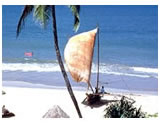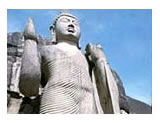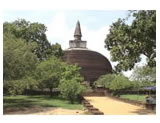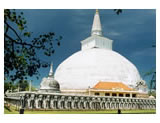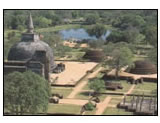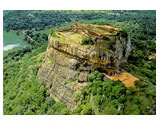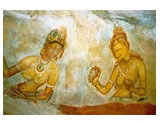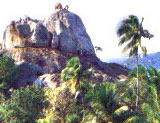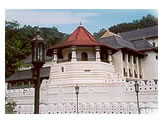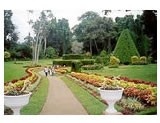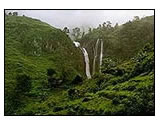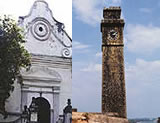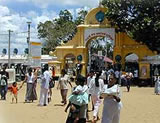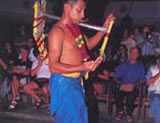 |
PLACES
OF INTEREST |
|
WASGAMUWA
NATIONAL PARK |
|
| Wasgamuwa
National park stands unique among the most of
national parks in Sri Lanka and the only national
park in the Central province where one could
see elephants in their natural habitat
|
|
| |
YALA NATIONAL
PARK |
|
Ruhuna
National Park at Yala is Sri Lanka's most popular
wild life safari destination. Situated about
300kM from Colombo the 1250 sq kM park is home
to leopards, crocodile, elephant, deer, sambar,
bear, wild bore, wild buffalo and peacock and
may varieties of birds including migratory birds
such as flamingos. The uniqueness of the park
is it's many different habitat diversities such
as dense jungles, lagoons and open park areas,
a beautiful sea front and rocky outcrops
There are many archaeological sites within the
park and the ancient monastery of Sithulpahuwa
situated at a beautiful rocky platform is among
it's most visited sites.
Salt pans at Palatupana
is a popular location for bird watching.
The leopards is the
largest member of the wild cats found in Sri
Lanka and Yala is probably the best location
to view these beast in their natural habitat
|
|
| |
BUNDALA
NATIONAL PARK |
|
This
is the latest addition to the National Parks.
All species of water birds resident on the country
and the migrant birds inhabit this Park.
There more than 400 species of birds are found
in Sri Lanka, indigenous varieties as well as
migrants which include peacock, the flashy jungle
fowl, the serpent eagle, flamingo, bee-eater,
many types of parrots, king-fisher, pond heron,
malabar pied hornbill, spoonbill
Bundala wild life
sanctuary where birds are seen in abundance.
If you want to see migratory shorebirds in
their thousands Bundala ramsar wetland is
an ideal place.
|
|
| |
UDAWALAWE
NATIONAL PARK |
|
The
Park is situated around a reservoir of the same
name in the south central area. Animals that
could be seen in herds are elephants and dear
species, wild buffaloes, wild boar, monkeys
and a variety of other species such as crocodiles,
peacocks, and if you are lucky the bear and
the leopard.
Udawalawe national park
in the south central region of Sri-Lanka (Dry
Zone) This national park extends in 30821
ha in land .A mixture of abandoned teak plantation
grassland and scrub jungle. Once you arrive
at the entrance to the park you board special
4 WD open safari jeeps and enter the park
.Once inside you wind your way through some
of the many paths the trekker guide will show
you, close encounters with elephants, deer
wild buffaloes, wild boar, monkeys and other
species like peacock ,crocodile is a sight
to see.
Its is guaranteed
you see elephants at close range may be even
a loner who would brush a side the jeep, you
would get good photographic opportunities,
bird life is good as you see species such
as large prinia, common tailorbird, purple,
sunbird scaly breasted munia, common wood
shrike black headed cukoo-shrike, getting
out of the jeep is not advised as many elephants
lay camouflaged behind the tall grass.
|
|
| |
MINNERIYA
NATIONAL PARK |
|
| The
Park is situated around a reservoir of the same
name in the south central area. Animals that
could be seen in herds are elephants and dear
species, wild buffaloes, wild boar, monkeys
and a variety of other species such as crocodiles,
peacocks, and if you are lucky the bear and
the leopard.
The extent of this National
Park is about 8889 hectares. There are wetlands
in this National Park, which have international
importance. It’s on the banks of the Minneriya
reservoir, which was built in the 4th century
A.D. Minneriya is a hide-out for many elephants,
where you could see herds of elephants approximately
50 to 60 in a herd. Animal and plant species,
which are plenty in the dry zone, are found
in this Park. Meanwhile wild elephants, samburs,
donkeys, apes, Indian mouse, deer, mongoose,
leopard, bats and reptiles like crocodiles,
pythons, monitors and various amphibians and
local and immigrant bird species are plenty
in this Park. Bamboo trees, which are rare in
other parks, are found in plenty in this park
and wild elephants can be seen conveniently.
The significant feature is that going close
to them can see these elephants. |
|
|
|
|
NEGOMBO |
| |
|
|
|
Negombo situated by the shores of
a lagoon by the same name once has been a trading port for
Portugese and Dutch and is a ideal place for those who want
quick access to and from the airport. Attractions in the
city are the old Dutch fort gate built in 1672 now a part
of the prison, the Dutch Canal which was then a supply route
to the Dutch administration, old churches and fishing villagers.
The 100km long canal running through the town is still being
used and is an attraction for those who want to see the
country from a different perspective. The stretch of road
towards Kotchchikade comes to life at dusk (most shops are
open at daytime too) with many handicrafts and curio shops,
gem shops, restaurants and internet cafes catering for tourists.
|
|
|
ANURADHAPURA |
|
| Anu-radha-pura
Kingdom lasted one thousand and five hundred years from 380BC. This
city is home to many of the earliest grandest monuments of Sri Lanka.
A popular destination of Sinhalese Buddhist's prilgimages because
of its many ancient Buddhist monuments.
Anuradhapura has been made royal capital by the king Pandukabhaya
in 380 BC. It remained residence and royal capital for 119 successive
Singhalese kings till the year 1000 AD when it was abandoned and
the capital moved to Polonnaruwa. You will see some of the most
famous as well as the tallest dagoba of Sri Lanka, remains from
palaces, temples, monasteries, ceremonial baths and the temple of
the holy Bo-tree. This tree was grown from a sapling of the very
tree under which more than 2500 years ago the Buddha found enlightenment
|
|
POLONNARUWA |
|
| Polonnaruwa
lies 216 km northeast of Colombo, 140kms northeast of Kandy and
104kms southeast of Anuradhapura. Sri Lanka's medieval capital (11th
- 12th Century AD) is a well-preserved city of ancient dagobas,
moonstones, beautiful parks, massive buildings and stunningly beautiful
statues. The majestic King's Council Chamber, the Lotus Bath, the
Lanka Thilaka Viharaya, the Gal Viharaya (rock temple) and the statue
of one of Polonnaruwa's great kings, Parakramabahu, are a few of
this capital's memorable sights. The Sea of Parakrama - a vast 12th
century man-made reservoir dominates the city. Although it is nearly
1000 years old, it is much younger than Anuradhapura, and in much
better repair. Moreover, the monuments here are located in a more
compact area, and their development is easier to follow
|
|
SIGIRIYA |
| |
Polonnaruwa
lies 216 km northeast of Colombo, 140kms northeast of Kandy and
104kms southeast of Anuradhapura. Sri Lanka's medieval capital (11th
- 12th Century AD) is a well-preserved city of ancient dagobas,
moonstones, beautiful parks, massive buildings and stunningly beautiful
statues. The majestic King's Council Chamber, the Lotus Bath, the
Lanka Thilaka Viharaya, the Gal Viharaya (rock temple) and the statue
of one of Polonnaruwa's great kings, Parakramabahu, are a few of
this capital's memorable sights. The Sea of Parakrama - a vast 12th
century man-made reservoir dominates the city. Although it is nearly
1000 years old, it is much younger than Anuradhapura, and in much
better repair. Moreover, the monuments here are located in a more
compact area, and their development is easier to follow
|
|
|
|
Mihintale regarded
as the cradle of Buddhism in Sri Lanka. The rock is dotted
with shrines and rock dwellings. A grand stairway of 1840
steps, 5m wide, leads to the summit with its splendid views
of the surrounding countryside.
Mihintale is a rocky hill 11 kilometers
east of Anuradhapura. It was here that in the year 247 B.C.
King Devanampiyatissa became converted to Buddhism in his
encounter with Mahinda. Mihintale, called the "Mountain
of Mahinda" soon became a great monastic city composed
of 4 rocky forested hills. Today, an aura of seclusion still
lingers here, despite a thriving bazaar at the foot of the
hills and the thousands of pilgrims who flock there. Every
person who wishes to reach the dagoba at the summit of this
sacred mountain must climb 1,840 steps to do so.
|
|
|
DAMBULLA ROCK CAVE TEMPLE
|
|
| The
1st century BC Caved Rock Temple in Dambulla contains the
most outstanding collection of Buddha’s images in Sri
Lanka. The walls are covered in paintings of images of Buddha
during his different reincarnations as well as depicting some
historic episodes. The Golden Mountain Temple was a monastic
settlement as early as the 2nd century BC which is now among
the seven World Heritage Sites of Sri Lanka. The rock rises
over 400 ft. above its surroundings and consists of 5 cave
temples spread out of about 50 acres. There you could see
one of the richest collections of 154 Sri Lankan sculptures
in the form of a large number of Buddha images in standing,
seated & recumbent postures as well as a few outstanding
figures of gods. Well preserved MASSIVE WALL AND CEILING PAINTINGS
covering 22,000 sq. ft. has made this temple complex more
important to the world |
|
|
KANDY |
|
Kandy, the last
royal capital of Sri Lanka is a major tourist destination. ( 115kM
from Colombo at 465 meters above sea level). Famous for the Temple
of the Tooth and many other temples the city could be called the cultural
capital of the island.
Kandy Perahera, the pageant of the temple of tooth where Buddha's
tooth is kept is held either in July or August each year to parade
the golden caskets is a must see itenary if one is visiting Sri Lanka
during these months. The final night procession is the most spectacular
event of the country. More than 50 elephants parade the city accompanied
by the drummers, dancers and chieftains.
he city established in the 15th century was the last royal capital
where 2500 years of royal rule ended. This bustling market town is
rich in cultural diversity has plenty of iteneries to offer to the
tourists from songs dances and handy crafts to ancient temples and
adventure activities. Kandy is a good transit point to the cultural
triangle to the north or hill country to the south. The city is also
a good source of souvenirs or to experience many cultural performances
at it's various hotels in the city. |
|
|
|
See
baby jumbos wondering around their cramped foster home or
bottle fed and bathed by their human foster fathers at Pinnawala,
about 90Km from Colombo towards Kandy is the home to some
60 or more elephant orphans. A place you will really enjoy
and never forget. Most orphans are accustomed to their curious
human visitors are harmless.
Started in 1972 the Elephant Orphanage
was relocated to at the present site in 1975 Bathing time
at Ma Oya just in front of the orphanage is sharp at 10.00am
and 2.00pm. Feeding time is about and hour earlier.
|
|
|
NUWARA
ELIYA |
|
Situated at around 2000m
above sea level and surrounded by lush tea plantations Nuwara Eliya
is the main hill resort of Sri Lanka and the heart of the tea industry.
Once a pleasure retreat of the European planters the town is still
very much an English town with many English style bungalows and buildings.
Nuwara Eliya is a good escape for those who miss cool breeze in tropical
Sri Lanka at any time of the year. Local tourists flock to this town
in their 'season' from March to May when it is the hottest duration
for the town, April being the busiest. Nuwara Eliya offers many activities
for tourists including visits to tea plantations golfing, horse riding,
boating, hiking and of course exploring the beauty of the landscaped
gardens, waterfalls and plateaus
|
|
HORTAIN PLAINS |
|
A national park, Sri Lanka's highest plateau is an excellent
excursion and a paradise for nature lovers, hikers and
bird watching. The grassy plains still host many other
wild lives. Also within the park are the World's End,
a shear drop of 1000m offers a breathtaking view of the
land below on clear days, Bakers Falls and and trails
for hikers.
|
|
|
GALLE |
|
The capital
of the southern province is a city with a colourful history. UNESCO
declared World Heritage Site the magnificent Dutch fort is the most
popular attraction of the town. 300 year old Dutch atmosphere is
still very much alive around the fort and amidst its many historical
buildings not invaded by the skyscrapers. The beautiful beach of
Unawatuna is just 6km south east of the city centre.
The southern coastal belt is the most
popular among the tourists and comes to life mainly from October
through April when the monsoon moves northeast and the sea becomes
calm with blue skies. The earliest European administrative centre
of Sri Lanka was the major port and the largest city until the
British shifted the port to Colombo. The City of Galle had been
the European administrative centre over 4 centuries.
|
|
|
|
Hikkaduwa is one of the earliest tourist beaches of Sri
Lanka famous for its sandy beaches and superb waves for
surfing. Once a popular coral reefs at Hikkaduwa are now
nearly extinct. There are many hotels and guest houses to
suit any budget with varying quality and comfort.
Your itenaries at Hikkaduwa may include hiring a glass bottom
boat for coral viewing, surfing, snorkelling, scuba diving
or simply relaxing in the beach.
|
|
|
KATARAGAMA |
|
Kataragama
a popular pilgrimage destination frequented by adherents of all
religions in Sri Lanka. The main shrine devoted to Skanda popularly
described in eulogies as God having six faces and twelve arms whose
assistance is sought for worldly gain. The history of the shrine
dates back to 2 century BC. The annual procession held in July or
August is the main event of the shrine with fire walkers and Kawadi
dancers. Offering to the got are made at 4.30am 10.30am and 6.30pm
daily.
Kataragama has a network of hotels, guest
houses as well as free pilgrim rests.
|
|
|
|
|
The gem-mining
centre of Sri Lanka is also a major crossroad between southern
plains and the hill country to the east. A bustling market
city servicing most of the surrounding towns. Many of the
prominent gem dealers in Sri Lanka operate from this town.
Scenery around the town is excellent and charming.
There is a route to Sri Pada from Ratnapura direction. Excursions
include Sinharaja Forest and Uda Walawe Wild Life Park. The
route towards hill country is beautiful. The surrounding area
is a popular trekking destination and a good place for bird
watching. Visit traditional gem mining and cutting operations
|
|
| |
|
 |

























